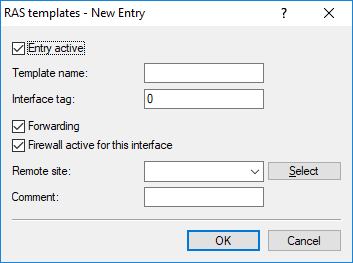There are basically two ways to manage the configuration of RAS remote stations:
- The user data or the configurations are locally stored on the device.
- The advantage of this alternative is that a RADIUS server is not necessary, which reduces the management and cost of the network infrastructure.
- The user data or the configurations are stored on an external RADIUS server.
- The advantage of this alternative is the centralized user management for extensive distributed network scenarios.
For RAS access via IPv6, you must also set up the corresponding RAS templates.

Entries in the RAS templates table have the following meaning:
- Entry active
- Enable or disable this RAS template here.
- Template name
- Here you define the name of the RAS interface that the IPv6 remote sites use for access.
- Interface tag
- The interface tag that you enter here is a value that uniquely identifies the network. All packets received by this device on this network will be internally marked with this tag. The interface tag enables the routes which are valid for this network to be separated even without explicit firewall rules.
- Forwarding
- Enables or disables the forwarding of data packets to other interfaces.
- Firewall active for this interface
- If the global firewall is enabled for IPv6 interfaces, you can disable the firewall for each interface individually here. To globally enable the firewall for all interfaces, navigate to and check the option IPv6 firewall/QoS enabled.
DANGERIf you disable the global firewall, the firewall of an individual interface is also disabled. This applies even if you have enabled this option.
- Remote site
- Specify the remote site or a list of remote sites for RAS dial-in users. The following values are possible:
- A single remote station from the tables under , or .
- The wildcard "*" makes the interface valid for all PPTP, PPPoE and L2TP peers.
- The "*" wildcard as a suffix or prefix of the peer, such as "COMPANY*" or "*TUNNEL" .
- Comment
- Enter a descriptive comment for this entry.
Information on RADIUS attributes for IPv6 RAS services can be found under RADIUS attribute extensions for IPv6 RAS services.
Note: If RAS clients are to be delegated to an IPv6 DNS server or are to receive their prefixes by prefix delegation, you must create a corresponding entry in the table DHCPv6 networks under .
Note: If you wish to authenticate a user by PPP list, you navigate to and enable the option Activate IPv6 routing for that user.
